1544 Search Results for link up
July 13, 2016
by Carole Zangari -
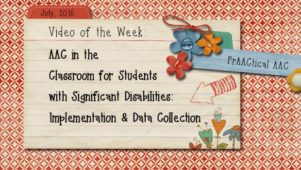
Today, we head back to AbleNet University for the second part of AT specialist and consultant Kelly Fonner’s presentation on advancing the communication skills of students with the most significant disabilities. In this video, Kelly goes deeper into implementation issues and discusses strategies for meaningful data collection. Missed the first part? You can check that out here. Kudos to Kelly and AbleNet University for hosting this series and making these videos freely available. Direct Link to Video: https://www.youtube.com/watch?v=BywUo_2es2E&ab_channel=ableUOn-demandProfessionalDevelopment
July 11, 2016
by Carole Zangari -
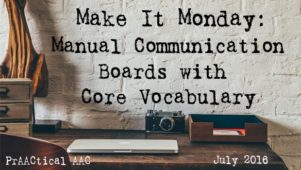
Welcome to Make It Monday, a series in which we hope to inspire your team to create communication boards and instructional materials for students who need or already use core vocabulary. In the first post, Getting Ready for a Core Vocabulary Journey, we talked about getting set up to make materials for expressive and receptive language use. Today, we get into making manual communication boards (MCBs). About Manual Communication Boards The term manual communication board refers to a ‘no-tech’ AAC support that students can use to express themselves. Typically printed on paper and laminated, most MCBs have grids of words organized by part of speech (e.g., verbs in one area, adjectives in another). MCBs that are designed for use in a particular activity, such as doing an art project or participating in Circle Time, are called activity-based communication displays, or ABCDs. ABCDs were very popular in the early days of... [Read More...]
July 6, 2016
by Carole Zangari -
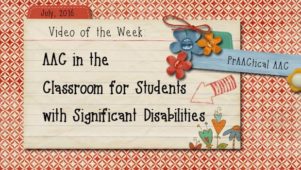
Most classrooms that include children with the most significant disabilities are comfortable with low tech AT and use it frequently throughout the day. In today’s video, AT consultant Kelly Fonner, discusses strategies for maximizing the use of those technologies and progressing to more advanced communicative options. A frequent presenter at international, national, and state conferences, Kelly shares ideas for taking what already works in these classrooms and moving to the next level. As always, she provides clear explanations, rationales, and the all-important ‘how-to’ for implementing additional strategies and technologies. Many thanks to Kelly and AbleNet University for making this video available. Direct Link to Video: https://www.ablenetinc.com/customer/account/login?referer=aHR0cHM6Ly93d3cuYWJsZW5ldGluYy5jb20vcmVzb3VyY2VzL3JlY29yZGVkX3dlYmluYXJzP3M9a2VsbHkrZm9ubmVyJnNvcnQ9JnBvc3RfdHlwZT1yZWNvcmRlZF93ZWJpbmFycw
June 22, 2016
by Carole Zangari -
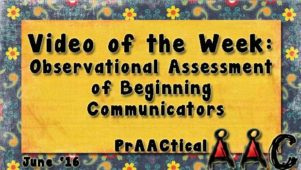
In last week’s video, we heard from SLP Maureen Nevers about the principles and practices used in assessing individuals who are at the beginning stages of communicative development. Today, we continue that theme and focus more specifically on using observation to collect assessment data on the form and function of communication. In this video, Maureen works through some video examples to demonstrate how brief observations of interaction can yield useful information about how and why the individual is communicating. You can visit their Communication Training Series webpage to see more from this wonderful team and get the specific resource documents for this presentation. Many thanks to the Angelman Syndrome Foundation for creating and sharing these videos. Direct Link to Video: https://www.youtube.com/watch?v=1qvvKNZEGMs&list=PLihsTkrStCHZVZBHDC0Qr7z10cYWC0ltx&index=36
June 15, 2016
by Carole Zangari -
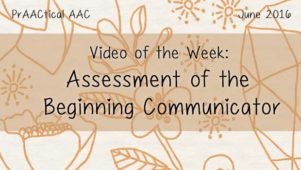
Looking to strengthen your assessment practices with beginning users of AAC? The Angelman Syndrome Foundation’s Communication Training Series has a two-part presentation on this topic that will be of interest to professionals and families alike. In this video, SLP Maureen Nevers discusses a range of prAACtical strategies and tools for gathering meaningful assessment data that helps guide intervention. One important note: Don’t skip this just because you are not currently working with individuals who have Angelman Syndrome. Like their other videos, the information in this presentation is relevant to those working with children, teens, and adults with a wide range of developmental disabilities. Direct Link to Video: https://www.youtube.com/watch?v=pgrsr8a2EKA&index=35&list=PLihsTkrStCHZVZBHDC0Qr7z10cYWC0ltx Kudos to the Angelman Syndrome Foundation for this outstanding series of training videos, and for making them freely available. Interested in this topic? Stay tuned for the second video on this topic in a future post.
June 8, 2016
by Carole Zangari -
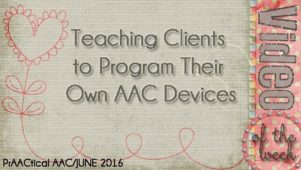
Parents, therapists, and educators share the common goal of helping AAC learners be as independent as possible and assert control over their own communication systems. One step toward this kind of self-advocacy is to teach our clients to add messages to their own AAC systems. In this video, Lindsey Cargill demonstrates how she introduced this to Katya. Enjoy! Direct Link to Video – https://www.youtube.com/watch?v=zo3x333cIy0
June 2, 2016
by Carole Zangari -
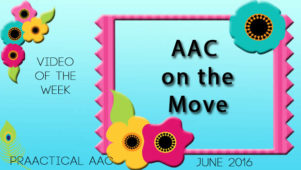
Strategies, tools, and implementation tips. SLP Maureen Nevers packed a lot into this terrific video on AAC strategies. Enjoy! Direct Link to Video – https://www.youtube.com/watch?v=8m9Qow6kWN8
May 25, 2016
by Carole Zangari -
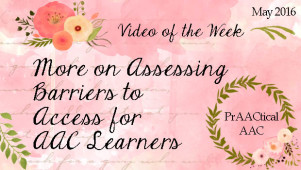
Today, we feature the second part of the presentation by Dr. Rae Sonnenmeier on assessing barriers to AAC. (You can see Part 1 here). In this video, she provides more in-depth information and prAACtical solution strategies. Many thanks to the Institute on Disability at the University of New Hampshire for making this available. Direct Link to Video – https://vimeo.com/86724224
May 23, 2016
by Carole Zangari -
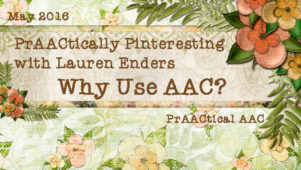
Even veteran clinicians and educators find themselves looking for resources to help others better understand what AAC is and why it may have been recommended in a particular situation. Today, we welcome back SLP Lauren Enders to introduce us to the information she has collected for this purpose. :::::::::::::::::::::::::::::: This month on PrAACtically Pinteresting, we’ll be taking a look at the board AAC: Why Use AAC?/Benefits of AAC. Very often, I am asked if I have resources that can be shared with team members or families who are reluctant to implement AAC. Often this reluctance results from of simple lack of information or beliefs in a variety of myths surrounding AAC use. I created this board to serve as an easily accessible repository of resources that can be shared with parents, professionals, or support staff who are hesitant to use AAC with their child/student/client. The board contains pins with information that... [Read More...]
May 18, 2016
by Carole Zangari -
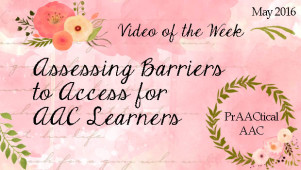
We’re continuing our journey of strengthening AAC assessment practices. In today’s featured video, we return to the Institute on Disability at the University of New Hampshire to consider additional ways to make our evaluation practices more meaningful. Many thanks to their AT team and Dr. Rae Sonnenmeier for this helpful information. Direct Link to Video – https://vimeo.com/80741615 Links to client videos referred to in the presentation Tyler: https://www.youtube.com/watch?v=WzqNPx1OVTU Holly: https://www.youtube.com/watch?v=woCsgnXwOyg









